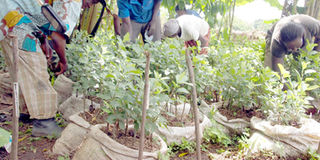Farmers take a chance on apples in the tropics

Farmers weed a nursery where apple seedlings are being grown. PHOTOS BY EPHRAIM KASOZI
What you need to know:
Most of the apples available in Uganda are imported. However, though from cooler regions of the world, some types of apples can grow well in Ugandan conditions.
Apple growing is thought to be only suitable for cooler temperate environments and this explains why apples consumed in Uganda are mainly imported, which costs the country huge amounts in foreign exchange. However, they can also be grown in warmer tropical lowlands as well as the cooler highlands of Uganda, which have been previously associated with apple growing such as Kabale.
Successfully grown
Dr John Baptist Lwanga, a farmer in Nakifuma, Mukono District, says there are varieties for the tropics that originated mostly in hot and humid parts of the world and that all have been tested in such temperatures.
“While still producing quality fruit, apples have been shown to be productive even where the temperature never falls below 10 degrees,” says Lwanga, who is also the Director, Kuffel Creek Apple Nursery of Uganda, a firm that operates large-scale apple tree nursery based in Mukono.
He explains that varieties like Anna and Dorsett Golden have been successfully grown in the tropics for years.
“But they have limitations such as lack of good colour, bruising during shipping, and poor storage ability,” he points out. At Kuffel Creek, which is a subsidiary of a US-based company, these and other varieties are grafted onto rootstocks that are proven to be virus-indexed and certified. They should also be very adaptable to light sand or heavy clay soils, as well as be drought-tolerant.
Grafting
“The trees are sold as benchgrafts—infant grafted trees about 45cm long, bare root with no leaves or soil. They are grafted with a bud of the desired variety and can be easily boxed and shipped. Once received the benchgrafts should be planted immediately, either in the field or in a raised bed in a nursery setting,” says Lwanga, whose firm also conducts farmer trainings.
He explains grafting is done because apples do not reproduce true to seed (no seeds produced for planting) and that the process of grafting shortens the period of fruiting.
“Apple growing does not allow intercropping to avoid pests, diseases and compromise on the taste but also the root system does not need weeding. One has to control weed by slashing and picking,” he adds. The farmers are instead advised and encouraged to do mulching.
Optimum conditions
Moses Bogere, who operates a nursery for apples in Wakiso, asserts that an interested farmer only needs to allocate some land to apple growing because the earnings start as early as plants produce branches.
“Once a farmer dedicates land, he can start selling seedlings in terms of scions and rootstocks as well as preparing and waiting for the fruiting period in 24 months,” he says.
The plant only needs about 20 litres of water immediately after planting to enable its roots to establish.
“Apples are planted in holes measuring 3 feet by 3 feet and 16cm deep, which are filled manure before planting.” Commercial apple trees consist of two parts that are grafted together to form the tree. The “scion” is the top portion that branches and bears fruit and is grafted onto a “rootstock”.
Soil fertility and pruning can determine tree size and therefore influences tree spacing, which is three meters each side. Apples require optimum growing conditions, and a mature tree ranges between 12 to 20 feet tall, depending on the variety.
===================================================
Types to grow in uganda
There are many that can be cultivated in Uganda but two types stand out as the most favourable. The best being the Anna Bred, which is a cross between the Red Hadassiya and Golden Delicious. It must be pollinated with Dorsett Golden or Shell of Alabama for size. The flesh is white, crisp, sweet, and juicy.
The second one is Dorset Golden. It is the best pollinator for Anna and an excellent apple in its own right, as it will grow anywhere and produces the year after planting. Just like Anna, it can be coaxed to bear two crops per year. It has a crunchy and juicy classic apple flavour. It has good flesh for pies and cider. They start to fall off the tree when ripe, and the flavour is best when just a little green.
When pollinated correctly with Anna, the apples have a distinct “blockish” shape. Their only disadvantage is that they bruise easily. These two are the most favourably grown in Uganda and are said to be the tastiest too.
Besides these, there are a number of other types. Arkcharm keeps its quality and colours up well despite high heat. It ripens earlier in the season and has a good sugar/acid balance and complex flavour. It has good disease resistance but does not keep very long and should be eaten right away; it would be good for processing into juice or dried apples.
Bramley cooking apple has proven to be reliable in a tropical climate. For an apple from such a cool climate it sure is not bothered by the heat.
Fuji is a sweet juicy apple, which requires a long, hot season to pump the full quota flesh. It takes about five years to start producing, but reliably sets a full crop every year after that. Ripens late and keeps extremely well.
William’s Pride, Tompkins County King, Terry Winter, Sierra Beauty, Shell of Alabama, Reverend Morgan, Red Rebel, Mollie Delicious, Lady Williams, King David and Granny Smith are other varieties. Most of the varieties that can be cultivated in Uganda offer resistance to pests and diseases.
Compiled by Fionah Agaba




